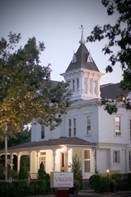 If you own a home in Champaign-Urbana, chances are good that it is eligible for designation as a local historic landmark, which would protect the home, but restrict changes to its exterior.
If you own a home in Champaign-Urbana, chances are good that it is eligible for designation as a local historic landmark, which would protect the home, but restrict changes to its exterior.
Champaign and Urbana combined have 28 local landmarks and five historic districts, but city planner Lacey Rains says that hundreds more properties may be eligible, including the majority of homes in Champaign. Although homes are usually nominated by their owners, owner approval is not required for the designation.
Once their home is a landmark, owners must seek approval from the Historic Preservation Commission in order to make changes to the exterior. Changes that are incongruent with the original style of the home are not permitted.
If neighbors fear that a home in their neighborhood is endangered, they can nominate the property for historic designation in an attempt to protect it. In early October, a house at 508 W. Elm in Urbana was made a local landmark, preventing owner Julian Gorski from selling it to developers who intended to raze it and replace it with apartment buildings.
Rains said, “In my opinion, the landmark designation worked exactly as it is intended — it protected a historic property from being demolished, protected the historic character of the neighborhood and protected surrounding residents from a building that would surely bring down the value of their properties.”
However, Paul Kapp, associate professor of architecture at the University of Illinois, says that this is not an appropriate use of historic designation. “Historic preservation is not land use planning,” he said.
Phyllis Williams lives in the West Main Street Historic District in Urbana and is pleased that her neighborhood’s designation last year prevented developer Howard Wakeland from tearing down three houses on the block for apartment buildings.
Williams says that Urbana has already lost many historic neighborhoods to development. “Where you see apartments (near campus), there used to be old homes,” she said. “This is not a community anymore.”
Karen Kummer, executive director of the Preservation and Conversation Association, says that replacing homes with apartment buildings, businesses, or parking lots creates a “hole in the landscape.” She says historic designation is often used to protect endangered homes, but that it shouldn’t influence land use planning.
Kristine Chalifoux of the Champaign Historic Preservation Commission says, “Communities have been hesitant to step up and take action” against homeowners’ desires. Two nominations in Champaign were not approved because the landlords objected.
“The sesquicentennial neighborhood (in Champaign) could be ideal (for preservation), but there are so many absentee landlords that don’t want it,” she said.
Another reason why many potential properties are not landmarks is simply lack of impetus. “It takes a lot of time and effort to nominate a property,” said Kummer.
One benefit for owners of landmark homes is that the character of their property (and neighborhood, in the case of historic districts), is preserved. “The constant concern is not what you’ll do to your house, but what your neighbor is going to do to their house,” Chalifoux said.
Historic districts help prevent this fear. When Williams’ neighborhood was named a historic district, her neighbors were forced to repair their deteriorating front porch.
Williams said that her neighborhood’s nomination helped her bond with her neighbors and created a tight-knit community.
“Landmark designations are important for the heritage of a community,” Kummer said. “It’s a tangible reminder of the past and makes for a much more inviting neighborhood.”
Chalifoux said that a landmark designation has little effect on an owner’s ability to sell their property.








